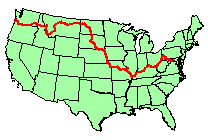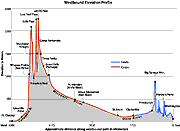The earth's surface is the most fundamental element in virtually all GIS
applications, because it influences or determines most geographic phenomena,
from river networks to road networks, retail sites to recreation sites,
hazardous areas to havens. We have decades of experience mapping, modeling,
analyzing, and visualizing terrain from local to global scales. We
have developed expertise and custom tools for solving a wide range of applied
challenges involving the earth's surface.
Terrain: Route MappingGIS provides tools to facilitate 3D route-mapping and planning, such as extracting the elevation profile along a route or to do more sophisticated modeling of times or costs as a function of true surface distances and elevations. Routes may come from existing data such as road networks, from survey or GPS data, or they may be derived from surface models and constraints.These images show a project we did for the Lewis & Clark Rediscovery Project, profiling the elevations of the historic expedition on its journey west and back. Given the map-view lines representing the expedition routes, we combined it with a national elevation dataset to obtain the elevations along the route which we delivered back to the project for annotation. The project page with this profile provides additional context and information about the geographic aspects of the expedition. |


